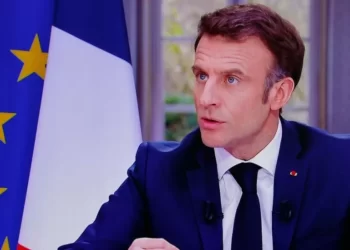Ukraine began resuming electricity exports to European countries on Tuesday, April 11, 2023, Energy Minister, Herman Halushchenko announced.
This marks a dramatic turnaround from six months ago when Russian bombardment of power stations plunged much of the country into darkness in a bid to dishearten the population.
The announcement by the Ukrainian Energy Minister that Ukraine was not only meeting domestic consumption demands but also ready to restart exports to its neighbors was a clear message that Moscow’s attempt to weaken Ukraine by targeting its infrastructure did not work.
Ukraine’s domestic energy demand is “100%” supplied, he told reporters in an interview, and it has reserves to export due to the “titanic work” of its engineers and international partners.
Russia increased infrastructure attacks in September, when waves of missiles and exploding drones destroyed about half of Ukraine’s energy system. Power cuts were common across the country as temperatures dropped below freezing and tens of millions struggled to keep warm.
Moscow said that the strikes were aimed at weakening Ukraine’s ability to defend itself, while Western officials said the blackouts that caused civilians to suffer amounted to war crimes.
Ukraine had to stop exporting electricity in October to meet domestic needs.
Engineers worked around the clock, often risking their lives to come into work at power plants and keep the electricity flowing. Kyiv’s allies also provided help.
Much more work remains to be done, Halushchenko said. Ukraine needs funding to repair damaged generation and transmission lines, and revenue from electricity exports would be one way to do that.
Besides the heroic work by engineers and Western aid, warmer temperatures are enabling the resumption of exports by making domestic demand lower. Nationwide consumption was already down at least 30% due to the war, Halushchenko said, with many industries having to operate with less power.
Renewables like solar and wind power also come into play as temperatures rise, taking some pressure off nuclear and coal-fired power plants.
Ukraine’s Energy Exports Start With Moldova

Energy Minister, Herman Halushchenko disclosed that the first country to receive Ukraine’s energy exports will be Moldova.
Exports to Poland, Slovakia and Romania are also on schedule to resume, he added.
“Today we are starting with Moldova, and we are talking about Poland, we are talking about Slovakia and Romania,” Halushchenko said, noting that how much will depend on their needs.
“For Poland, we have only one line that allows us to export 200 megawatts, but I think this month we will finish another line which will increase this to an additional 400 MW, so these figures could change.”
Herman Halushchenko
However, it is unclear if Ukraine can keep up exports amid the constant threat of Russian bombardment.
“Unfortunately, now a lot of things depend on the war. I would say we feel quite confident now until the next winter.”
Herman Halushchenko
Export revenue will depend on fluctuating electricity prices in Europe. In 2022, while Ukraine was still able to export energy, Ukrainian companies averaged 40 million to 70 million euros a month depending on prices, Halushchenko said.
“Even if it’s 20 (million euros) it’s still good money. We need financial resources now to restore generation and transmission lines,” he said.
Ukraine began trading electricity with European countries in June, 2022, in a bid to move away from Russia’s sphere of influence. Power lines were synchronized in March 2022, shortly after the war began.
Engineers sped up the process to link Ukraine to the continental grid, allowing it to decouple its power system from Russia. Moldova was added later. Before that, Ukraine and Moldova were part of a power sharing system that included Russia and Belarus.
According to Energy Analyst, Olena Pavlenko of the Kyiv-based think tank, Dixie Group, the resumption of exports is an obvious win for Ukraine, but it also benefits Europe.
READ ALSO: Hungary Signs New Energy Deal With Russia





















